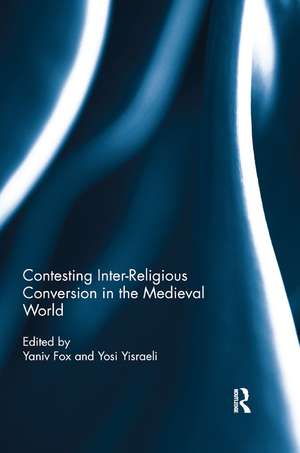Contesting Inter-Religious Conversion in the Medieval World
Editat de Yosi Yisraeli, Yaniv Foxen Limba Engleză Paperback – 12 dec 2019
| Toate formatele și edițiile | Preț | Express |
|---|---|---|
| Paperback (1) | 386.81 lei 6-8 săpt. | |
| Taylor & Francis – 12 dec 2019 | 386.81 lei 6-8 săpt. | |
| Hardback (1) | 1054.71 lei 6-8 săpt. | |
| Taylor & Francis – 12 dec 2016 | 1054.71 lei 6-8 săpt. |
Preț: 386.81 lei
Nou
Puncte Express: 580
Preț estimativ în valută:
74.02€ • 80.65$ • 62.37£
74.02€ • 80.65$ • 62.37£
Carte tipărită la comandă
Livrare economică 23 aprilie-07 mai
Preluare comenzi: 021 569.72.76
Specificații
ISBN-13: 9780367881665
ISBN-10: 0367881667
Pagini: 284
Dimensiuni: 152 x 229 x 15 mm
Greutate: 0.39 kg
Ediția:1
Editura: Taylor & Francis
Colecția Routledge
Locul publicării:Oxford, United Kingdom
ISBN-10: 0367881667
Pagini: 284
Dimensiuni: 152 x 229 x 15 mm
Greutate: 0.39 kg
Ediția:1
Editura: Taylor & Francis
Colecția Routledge
Locul publicării:Oxford, United Kingdom
Cuprins
Introduction
[Yaniv Fox and Yosi Yisraeli]
1. Conversion as a Historiographical Problem: The Case of Zoraya/Isabel de Solís
[Ryan Szpiech]
Part I: Regulating Conversion
2. Conversion on Trial: Toleration of Apostasy and the Trial of Three Converts to Judaism in the Dutch Republic, 1614-5
[Alexander van der Haven ]
3. Anxieties in Conflict: The Ratto of Anna del Monte
[Kenneth Stow]
4. Normative Texts as Sources for Conversion to Christianity in Europe
[Roy Flechner]
5. Royal Policy and Conversion of Jews to Christianity in Thirteenth-Century Europe
[John Tolan]
Part II: Social Realities of Inter-Religious Conversion
6. The Donor and the Gravedigger: Converts to Judaism in the Cairo Geniza Documents
[Moshe Yagur]
7. Conversion as an Aspect of Master-Slave Relationship in the Medieval Egyptian Jewish Community
Craig Perry
8. Returning Apostates and Their Marital Partners in Medieval Ashkenaz
[Ephraim Kanarfogel]
9. Conversion and Return to Judaism in High and Late Medieval Europe: Christian Perceptions and Portrayals
[Paola Tartakoff]
Part III: Narrating Conversion
10. Conversion from the Worst to the Best: The Relationship between Medieval Judaism, Islam, and Christianity
[Irven Resnick]
11. The Role of Preaching in the Conversion to Islam
[Linda G. Jones]
12. Between Tyranny and the Commonwealth: Political Discourses and the Framing of Violence against Conversos in the Gesta Hispaniensia of Alfonso de Palencia
[Yanay Israeli]
13. Converting Bodies, Embodying Convers
[Yaniv Fox and Yosi Yisraeli]
1. Conversion as a Historiographical Problem: The Case of Zoraya/Isabel de Solís
[Ryan Szpiech]
Part I: Regulating Conversion
2. Conversion on Trial: Toleration of Apostasy and the Trial of Three Converts to Judaism in the Dutch Republic, 1614-5
[Alexander van der Haven ]
3. Anxieties in Conflict: The Ratto of Anna del Monte
[Kenneth Stow]
4. Normative Texts as Sources for Conversion to Christianity in Europe
[Roy Flechner]
5. Royal Policy and Conversion of Jews to Christianity in Thirteenth-Century Europe
[John Tolan]
Part II: Social Realities of Inter-Religious Conversion
6. The Donor and the Gravedigger: Converts to Judaism in the Cairo Geniza Documents
[Moshe Yagur]
7. Conversion as an Aspect of Master-Slave Relationship in the Medieval Egyptian Jewish Community
Craig Perry
8. Returning Apostates and Their Marital Partners in Medieval Ashkenaz
[Ephraim Kanarfogel]
9. Conversion and Return to Judaism in High and Late Medieval Europe: Christian Perceptions and Portrayals
[Paola Tartakoff]
Part III: Narrating Conversion
10. Conversion from the Worst to the Best: The Relationship between Medieval Judaism, Islam, and Christianity
[Irven Resnick]
11. The Role of Preaching in the Conversion to Islam
[Linda G. Jones]
12. Between Tyranny and the Commonwealth: Political Discourses and the Framing of Violence against Conversos in the Gesta Hispaniensia of Alfonso de Palencia
[Yanay Israeli]
13. Converting Bodies, Embodying Convers
Descriere
The compositions of this volume discuss the phenomenon of inter-religious conversion in the Mediterranean and its hinterlands from the seventh to the seventeenth centuries. Taken together, they argue that the cultural and social implications of this phenomenon were mutually recognizable by contemporaries and therefore may be comparatively discus
